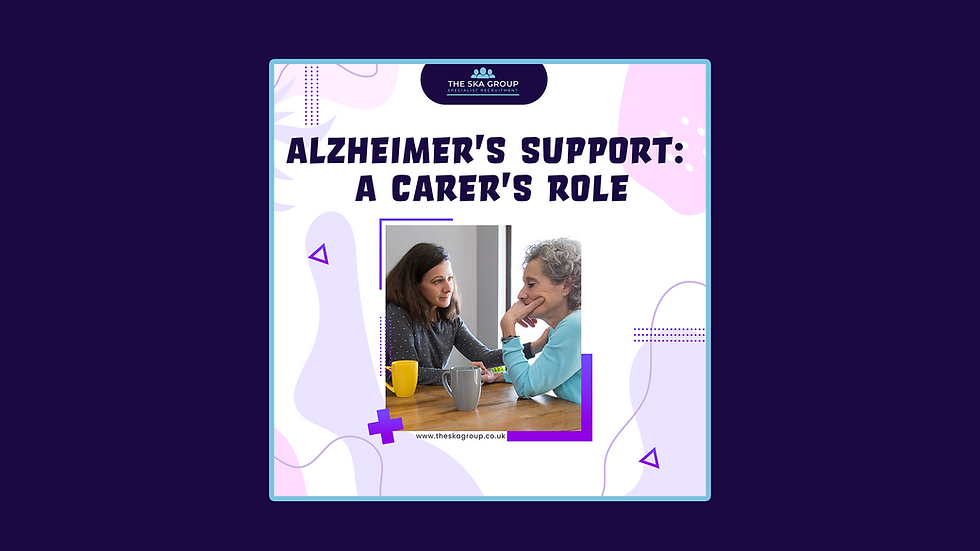Tools Empowering the Deaf Blind Community
- Emily

- Jun 24
- 3 min read
Living with both sight and hearing loss presents unique challenges, but thanks to rapid advances in technology and innovation, people with deafblindness are experiencing more independence, inclusion, and empowerment than ever before.
This Deafblind Awareness Week, we’re exploring the remarkable tools and solutions that are transforming the lives of people with dual sensory loss.
Whether it’s improving communication, navigation, or day-to-day tasks, technology is playing a key role in breaking down barriers and building bridges to connection.
Understanding Deafblindness
Deafblindness is a combined loss of sight and hearing that affects a person’s ability to communicate, access information, and navigate the world around them. It can be congenital (from birth) or acquired later in life, and it varies widely in degree.
For many in the deafblind community, traditional aids designed for just one sensory loss (like hearing aids or magnifiers) may not be sufficient. This is where specialised, inclusive technology becomes essential.
1. Communication Technology: Bridging the Gap
Communication is often one of the biggest hurdles for people with deafblindness.
Thankfully, several tools and apps are making it easier than ever to connect with others.
Braille Displays and Notetakers: These tactile devices convert text from a screen into Braille, allowing users to read messages, books, and documents. Devices like the HumanWare Brailliant or Freedom Scientific Focus help deafblind users communicate and access content independently.
Deafblind Communicators: Devices like the DeafBlind Communicator (DBC) combine a Braille keyboard, display, and a standard mobile phone, enabling back-and-forth conversations with hearing/sighted people.
Speech-to-Text Apps: Apps like Ava or Live Transcribe convert speech into text in real time, helping users follow conversations. When paired with a Braille display or screen reader, they become even more accessible for people with dual sensory loss.
2. Mobility and Navigation Tools: Enhancing Independence
Moving through the world safely and confidently is a fundamental part of independence. Technology is playing a growing role in helping those with deafblindness navigate their environments.
GPS and Wayfinding Apps: Apps like Lazarillo and BlindSquare offer audio and tactile navigation cues tailored to those with visual impairments. When used with hearing aids or vibrational alerts, they can guide users through busy streets and unfamiliar places.
Wearable Tech: Innovations like Sunu Band—a sonar-based wristband that uses vibrations to indicate obstacles—help people detect nearby objects and avoid hazards.
Smart Canes: High-tech mobility aids such as the WeWalk Smart Cane combine GPS, voice assistance, and obstacle detection to enhance safety and autonomy.
3. Home Technology and Daily Living Aids
Smart home technology has become a game-changer for people with sensory disabilities.
Voice and App-Controlled Devices: Tools like smart speakers (e.g. Amazon Alexa, Google Home) allow users to control lights, appliances, and even thermostats with simple commands or apps.
Vibration and Light Alert Systems: For safety and awareness, these systems can signal doorbells, alarms, or phone calls through flashing lights or vibrations—essential for those who may not see or hear traditional alerts.
Customizable Assistive Apps: Apps that manage medication schedules, calendar reminders, or visual alerts are often adaptable for deafblind users, promoting greater self-management and confidence.
4. Innovative Communication Methods
Beyond hardware and software, new methods of tactile communication are also gaining traction.
Tactile Signing: Used when both vision and hearing are limited, tactile sign language allows the person to feel signs through touch. Technology-assisted training and virtual platforms are helping carers and families learn this vital skill.
Haptics and Tactile Messaging: Research into wearable haptics (like vibrating wristbands or jackets) is enabling a new way to “feel” messages through touch—creating exciting opportunities for more fluid, discreet communication.
5. The Power of Inclusive Design
Perhaps the biggest shift is the growing emphasis on inclusive design—technology created with accessibility at its core, not as an afterthought.
Many companies are now working directly with deafblind individuals to test, co-design, and improve assistive devices. This collaboration ensures the tools are not only functional but user-friendly, comfortable, and genuinely empowering.
Moving Forward
Technology can never replace the importance of human connection, understanding, and care—but it can absolutely enhance it.
As carers, friends, family, and professionals, staying informed about these innovations allows us to better support the deafblind people in our lives. Whether that means introducing a new communication device, adapting a home environment, or simply being aware of how these tools work—it all makes a difference.
Final Thoughts
This Deafblind Awareness Week, let’s celebrate the progress made—and commit to continued innovation and inclusivity. Every new tool, app, and idea brings us closer to a world where people with deafblindness can thrive on their own terms.
Technology is not just about gadgets. It's about access, autonomy, and equality.




Comments